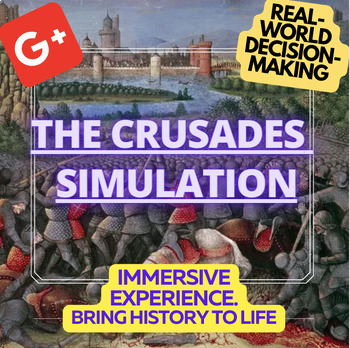The Crusades Simulation
- Word Document File
Description
Hi, friends and welcome!
I'm so excited to share this resource with you!! This is my immersive, real-world, hands-on The Crusades Simulation. This simulation aims to immerse students in the historical context and complexities of the Crusades, a series of religious and military campaigns that took place during the Middle Ages. By assuming the roles of key figures and factions, students will analyze historical events, make critical decisions, and explore the impact of the Crusades on societies, cultures, and diplomacy.
To learn more about my simulations and their structure, please watch this short video here.
In essence, students are placed into small groups and have to make real-world and historical decisions, including:
1) Scenario 1: Siege of Jerusalem
Scenario Description: Your group represents the Christian Crusaders during the First Crusade, and you are faced with the challenge of capturing the holy city of Jerusalem from the control of the Muslim forces.
2) Scenario 2: Reconquest of Edessa
Scenario Description: Your group represents the Muslim forces during the Second Crusade, and you are tasked with defending the city of Edessa from the advancing Crusader armies.
3) Scenario 3: Clash of Cultures in Outremer
Scenario Description: Your group represents a multicultural community in Outremer (the Crusader states in the Levant), comprising Christians, Muslims, and various ethnic and religious minority groups. As tensions rise between the different communities, you are faced with the challenge of maintaining peaceful coexistence and addressing conflicts that threaten the stability of the Crusader states.
4)Scenario 4: Reconquest of Acre
Scenario Description: Your group represents the Mamluk forces during the late stages of the Crusades, and you are tasked with recapturing the city of Acre from the Crusader occupiers.
The simulation ends with a thorough debrief section about what actually happened in history.
I love to engage my students in simulations because they provide a dynamic and immersive learning experience that goes beyond the pages of a textbook. By stepping into the shoes of historical figures and making decisions, students develop a deeper understanding and empathy for the challenges, complexities, and human stories of the past. My simulation foster critical thinking skills, encourage teamwork and collaboration, and allow students to explore different perspectives and outcomes. Through such interactive experiences, students forge a deeper engagement with history, realizing that the decisions made by individuals and societies in the past have far-reaching consequences that shape the present and future.
This resources includes 11-pages of content:
- Clear instructions for the teacher
- Ample context about the Crusades
- Scenario sheets for students



